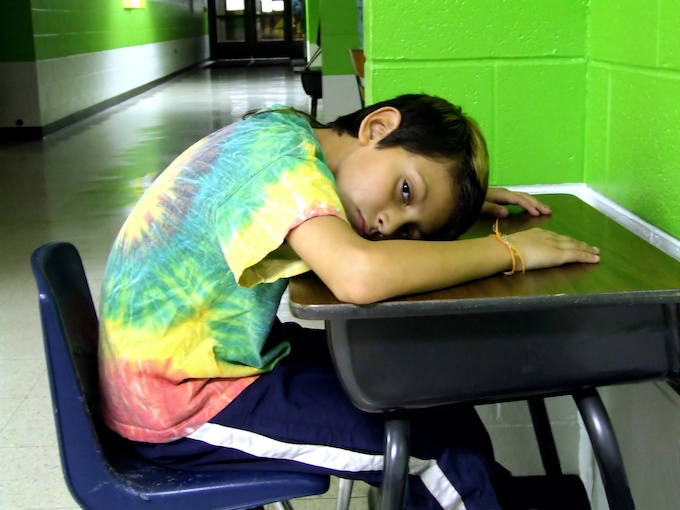Principals struggle to obtain help for children

This year, TTPA carried out a survey of schools in the North and has released some independent analysis of the results.
“Principals in Te Tai Tokerau are still struggling to receive the necessary help needed to deal with the results of trauma and abuse of the kids in our schools, yet this problem has been known for years!” says Pat Newman President Te Tai Tokerau Principals Association.
“It confirms the current situation, what we in the north face on a daily basis,” said Pat. “Whilst I must acknowledge the work by Minister Martin in attempting to cover some of these needs, the reality is that the problem is so great that one can’t help feel finding this help is a bit like finding a pimple on an elephant’s bum….!”
“What is worse, is the lack of help, specifically from some of the services provided by the DHB. It truly needs to look long and hard at why Principals have little confidence, and why the high level of dissatisfaction.”
“On the other hand Ministry and educationally based help, scores far higher but is totally hampered by the size of the problem and he resources available”
“The question really is, will we still be talking about this huge problem in another ten years, or will finally those with the power say enough is enough and provide the required resources for Te Tai Tokerau?”
Excerpts from the report:
The incidence of self-harm was concerning. While this category of severe, problem behaviour was the second lowest reported, more than a third of the responding principals (29), dealt with students with self- harm behaviours. This signifies considerable distress for the children involved.
A significant number of principals (19%) believed that their health had been compromised by the stresses and battles they faced in this work. The level of distress was such that 7 (8%) principals felt a sense of dread in coming to work. By far the majority described their anger (64%) and frustration (52%) about the lack of resources for this work. Continually fighting to gain the services and resources (57%), while dealing daily with the struggles to manage their workload and daily firefighting behavioural issues as they occurred (61%), contributed to the stress some felt. Comments attached to this section noted that five principals experienced sleeplessness and resultant exhaustion and tiredness.
Specialist Child Health Services with conditions requiring physical health assessments and interventions received largely favourable ratings (70%). The service was used in term one of 2019 by 40 schools with 28 rating the service as satisfactory, good or very good.
In contrast, ratings of Child and Adolescent Mental Health: Te Roopu Kimiora achieved a favourable rating from 14 principals and a negative rating from 32. This corresponds to a 30% positive rating of satisfactory or good, (none were rated very good). The bureaucratic requirements for referrals, followed by under-resourced, unresponsive and untimely services accompanied by poor communication informed these negative perceptions
The most commonly used service to assist teachers and children with severe, problem behaviours was the Resource Teacher Learning and Behaviour (RTLB) service. It was also the most highly rated with 76.5% of schools giving a positive rating.
Survey One: Severe Problem Behaviour in Te Tai Tokerau Schools, Years 1- to 8.
- Both high and low decile schools experienced incidences of severe, problem behaviour, but the frequency of these behaviours were higher in low decile schools
- Boys were more likely than girls to have severe problem behaviour by a ratio of 4:1
- The most common forms of severe problem behaviour involved student to student interactions such as swearing in (90%) of schools; threats of physical violence (82%); acts of physical violence (76%); bullying (87%); stand over or intimidation tactics (75%); use of sexualized language (68%) and these behaviours were sometimes directed at teachers/teacher-aides as well.
- Leaving the classroom without permission was a common behaviour in schools that while disruptive, was not directed at others (88%)
- Less commonly, severe, problem behaviours involved interactions between students and teachers/teacher-aides. These were nevertheless significant: verbal abuse (71%); threats of violence (45%); physical violence (38%)
- The least common forms of severe, problem behaviour in schools, which did not involve other students were masturbation (16%) and self-harm (35%), but these proved both challenging to manage and created significant concern where they occurred.
- Most principals found the management of severe, problem behaviours challenging. They were angered by the lack of resources available to them and felt frustrated when repeated efforts to meet the needs of some children for specialized services resulted in failure.
- 53% of principals reported that their capacity to manage their workload was affected by the need to manage incidence of severe problem behaviour
- 19% experienced impacts on their health and wellbeing
Survey Two: About the Child with Severe, Problem Behaviour
This survey gathered data about 244 children (total population 8,917) in 44 schools with severe, problem behaviour, including conditions such as ADHD, ODD, FASD, ASD, Chronic Anxiety and Self-Harm. The condition of Trauma emerged in the data and has also been discussed.
- Boys were more likely have behavioural conditions by a ratio of 4:1
- ODD was most commonly reported at 1.4% of the population of students
- ADHD was reported in 1.1% of the population
- Chronic Anxiety was reported at a rate of 0.8% of the population
- FASD was reported 0.8% of the population
- ASD was reposted at 0.6% of the population
- Trauma was reported at 0.3% of the population, but reporting depended on its appearance in free text space and therefore, is likely to be underreported
- Self-Harm was reported at 0.25% of the population.
All these conditions fall below conservative estimates of prevalence in the literature.
- Requests for classroom support totalled 1954 hours at an average of 15.6 hours per child in term one, 2019
- Classroom hours received totalled 973 at an average of 7.6 hours, less than half of the hours requested.
- 20 children were allocated all the hours requested, 44 children were allocated none, 61 children were allocated less hours than requested.
The failure of existing services to meet the needs of children with severe, problem behaviours in Te Tai Tokerau under conditions in which they appear to be underreported suggests that there is a significant need for greater attention and resourcing in this area.









